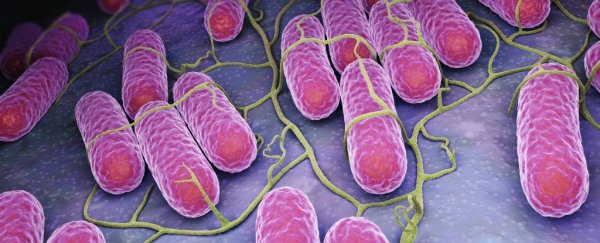There's been a lot of talk surrounding superbugs recently – and rightly so. Without a new approach to fighting bacterial infections, we might be looking at 10 million deaths a year caused by resistant bacteria by 2050.
So what can we do? Some researchers are looking at the tiny inner workings of different bacteria, especially their proteins, to try and work it out.
Two international groups, both including researchers from the University of Technology Sydney (UTS), have been looking at how pathogenic bacteria use enzymes to cleave (or break up) their proteins into smaller, functional pieces.
This is good for the bacteria, as they can then use the smaller pieces to interact with the victim's cells in different ways.
The first of the two research teams, based in the ithree institute, identified how a protein called "elongation factor Tu", which is found in all bacteria, can actually 'moonlight', with various protein functions, even when it's been cleaved.
Elongation factor Tu is known as a moonlighting protein, and the team discovered that the protein can be split apart and still have these 'moonlighting' functions.
"Cleavage fragments of cytosolic proteins that moonlight on the cell surface add another layer of complexity to the concept of multifunctional proteins," said UTS PhD candidate and researcher, Michael Widjaja.
"Processing (cleaving) has implications for how these pathogens establish infection and it's a concept that may now be investigated in a broader selection of pathogens."
The second research team also looked into multi-functional proteins, and found that a bacterium called Mycoplasma hyopneumoniae had the ability to cleave a number of proteins, which then could enter and infect a host more easily.
They looked at 164 different proteins, and identified 669 N-terminal peptides – which represent where the bacteria cleave.
"Bacteria continue to develop resistance to many commonly used antimicrobials, so we desperately need to learn more about these bugs in order to create new therapeutics," said another researcher, Iain Berry, from the UTS ithree institute.
"Our research into Mycoplasma hyopneumoniae means that the proteins actually responsible for the cleavage can now be targeted and the cleavage process blocked."
This type of research is important if we're going to be able to actually fight superbugs. Although we have lots of information about these tiny pathogens, we still don't completely understand how they work at the molecular level.
Understanding this might help us finally crack the case wide open.
The papers were published in Scientific Reports, and can be viewed here and here.
UTS Science is a sponsor of ScienceAlert. Find out more about their research.
